Description
Ground Hornbill is an easily recognized bird that is classified as amongst the ‘big six’ avian species of Southern Africa. They are entirely carnivorous and are therefore indicators of a constant supply of a wide range of species including mammals, birds, and reptiles. They are able to move over long distances and therefore have a wide range of habitat choices. Preferred habitats are therefore able to supply all of their requirements from a diverse and reliable supply.
Identification
Ground Hornbill is a very large bird, mainly black; facial wattles are bright red, and blue in the center of the throat of the male and wings are white in flight. It can be found in open grassland to bush veld SE to NE and N uncommon to the scarce resident. The average length is about 90-129 cm long with a weight is 3600 – 3950.
However, females’ weight is a little lighter than males. The bare parts are Iris yellow; the skin of the face, throat, and wattles bright red, bluish in the center of the throat in females; legs and feet black, soles whitish. The size is very large; turkey-like; mostly black; in-flight primaries white; red wattles distinctive; female usually has purplish-blue also on the face, orbital skin, and wattles. Immature is a bit browner than an adult; facial and gular skin light khaki; bill dark gray.
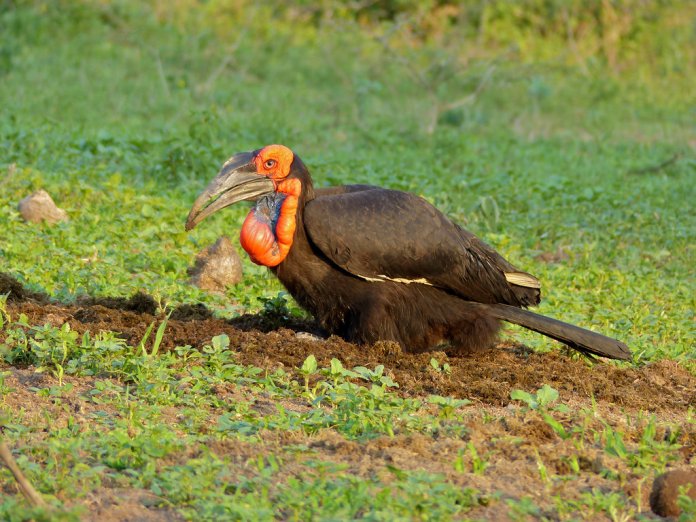
Voice
Ground Hornbill’s voice is the deep booming territorial call of 4-5 syllables. That is falling in pitch, started by one bird, replied to by a second bird in a lower tone. The bird voice is du, du, dududu, sometimes hu, hu huhu, or du, du, dududu, hu, hu, huhu, etc. The Ground Hornbill call is repeated several times, the bill pointing downwards. Hence, the neck is arched and inflated. The soft uhu contact call is a grating squawk high-intensity alarm or fear call. This is a vocal bird, one can listen to the voice from a distance of up to three kilometers.
Distribution
The bird is mainly found in Southern Africa of the equator; confined to E, NE, and N. This is one of the largest species of hornbill worldwide solely within Africa. The bird is found in Namibia, Angola, South Africa, Zimbabwe, Kenya, Burundi, Malawi, Tanzania, Zambia, Mozambique, and Swaziland. Ground Hornbill are non-migratory birds and prefer to remain in their defined territory around the year.
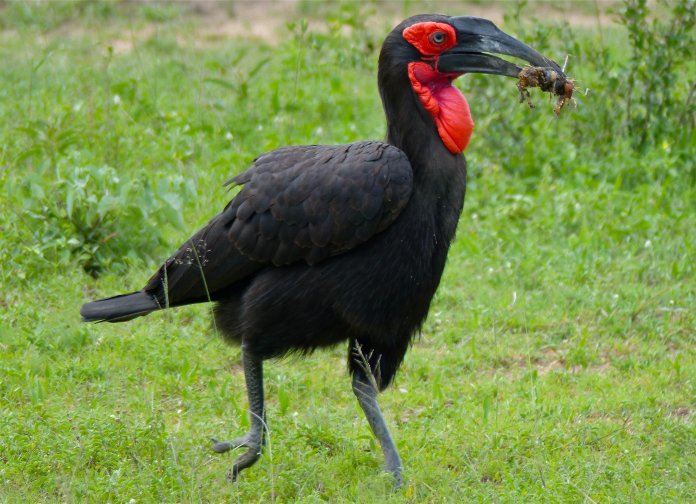
Status
Ground Hornbill is a locally common resident, but scarce in settled areas; some local movements. The bird population is declining due to poisoning, loss, transformation of habitat, persecution, and electrocution. The species is listed as endangered and vulnerable.
Habitat
The Ground Hornbill is habitat is woodland, savanna, open grass veld, and agricultural lands. It moves slowly in a group, foraging for food. It stays 75% on the ground, however, can also fly. The wingspan is about 4 ft across, which can help him to fly up to 17-19 miles an hour.
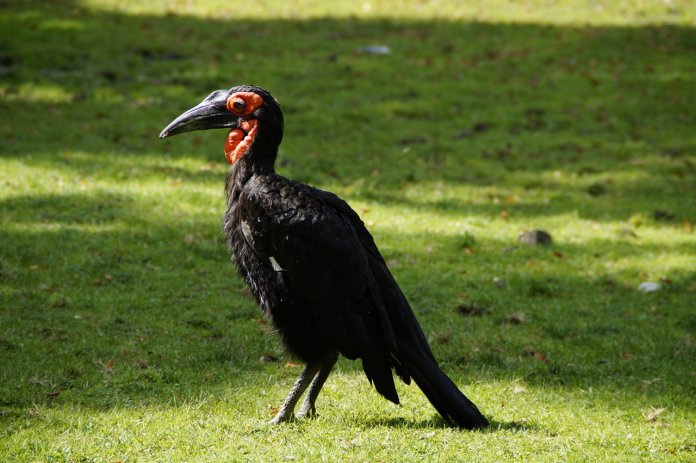
Habits
In pairs or groups of usually not more than 8 birds (2-4 adults and 1-3 immature); the mean group size of 3,6 birds. This is neighboring groups chase each other in aerial pursuits. Forages on the ground, walking with a stiff rolling gait on terminal phalanges of toes; digs with a bill for the food.
The vocal is mostly early morning; also late afternoon. Also, the flight is powerful with deep wing beats, and little gliding. Roosts in groups at ends of branches, head tucked into shoulders, bill pointing upwards.
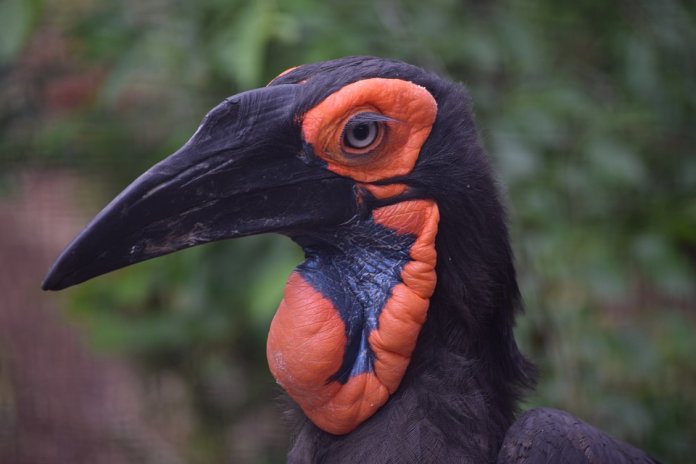
Food
Ground Hornbill is entirely carnivorous; prefers to eat reptiles (including tortoises), frogs, snails, lizards, rodents, snakes, mealworms, and insects; also mammals up to the size of a hare.
Breeding
The breeding season is from October to November. The eggs lay earlier after good rains, usually within 10 days of the first summer rains. Nest: The bird usually made a hole in a tree; or in the rock face or wall of a donga. They made a nest at height above ground (12) 4-5,7-7 m; one cliff nest 120 m above ground.
The nest is lined with grass and leaves; the cavity is about 40 cm wide; the entrance is about 30 cm wide, not sealed as in other hornbills. Clutch: The size is (37) 1-1, 8-2 eggs. Eggs: White, rough-textured; measure (27) 73,9 x 51,3 (67,3-79 x 46,9-55,7). Incubation: The incubation is about 40 days by dominant female-only; females are fed by adult males and sometimes by immature. Nestling: took 85-87 days; dependent on adults for food for 6-12 months.
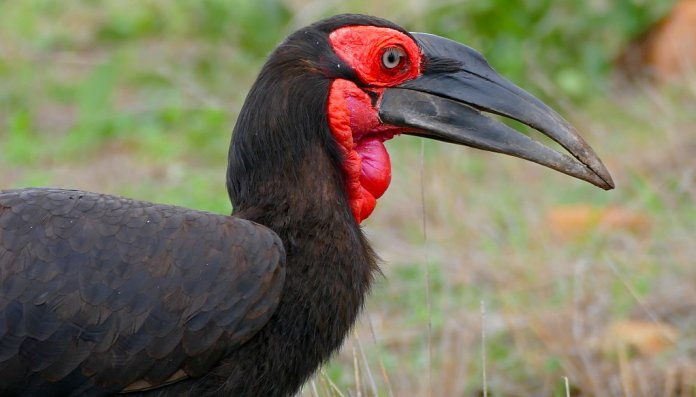
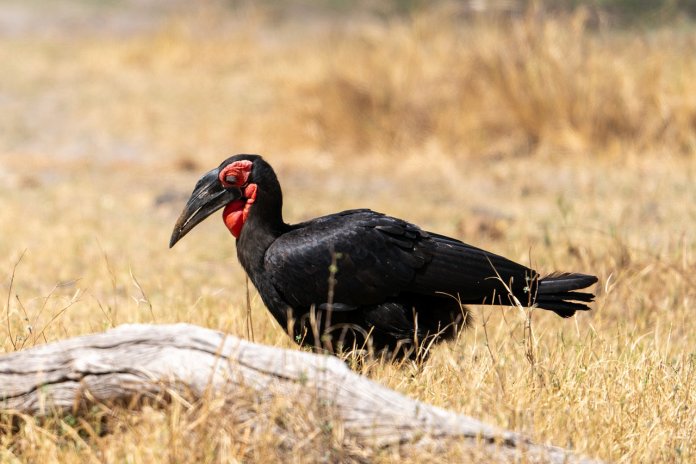
Related Reading – Rhinoceros Hornbill Facts / Rufous-necked Hornbill






